Qiu X.G. (Ed.) High Temperature Superconductors
Подождите немного. Документ загружается.

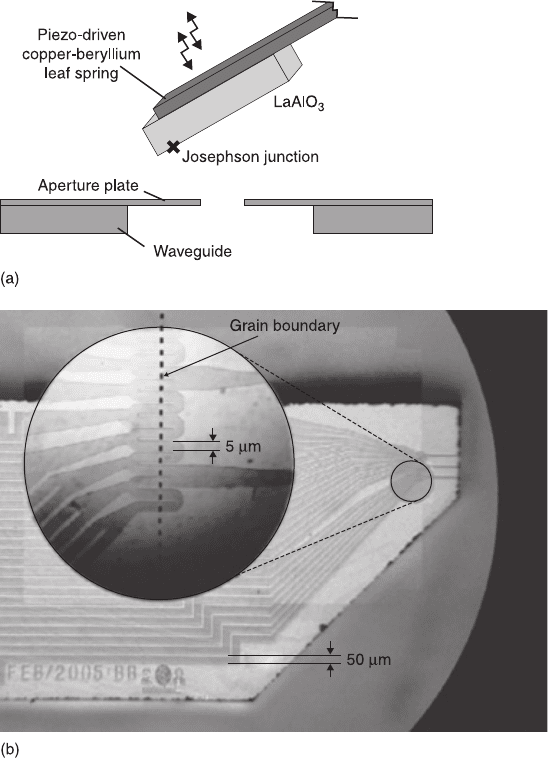
342 High-temperature superconductors
1
2
3
4
5
6
7
8
9
10
1
2
3
4
5
6
7
8
9
20
1
2
3
4
5
6
7
8
9
30
1
2
3
4
5
6
7
8
9
40
1
2
43X
© Woodhead Publishing Limited, 2011
barrier thickness too much. The use of noble elements Au und Ag for non-epitaxial
types of junctions is possible but the problems with the control of the interfaces
(e.g. growth and interface resistance) are a handicap to these junctions.
Very promising results were obtained for ‘native’ or ‘natural’ barriers where
etched surfaces of high-T
c
superconductors are used as interface-engineered barriers.
8.21 (a) Schematic drawing of the setup used for microwave scanning
microscopy and (b) layout of the Josephson cantilever (Schilling
et al., 2006, Figs 1 and 2, Copyright (2006) by the American Institute of
Physics). Reprinted with permission from Schilling M, Kaestner A, and
Stewing F (2006), ‘Room temperature near field microwave imaging
with an YBa
2
Cu
3
O
7
Josephson cantilever’, Appl. Phys. Lett. 88, 252507,
Figs 1 and 2, Copyright (2006) by the American Institute of Physics.
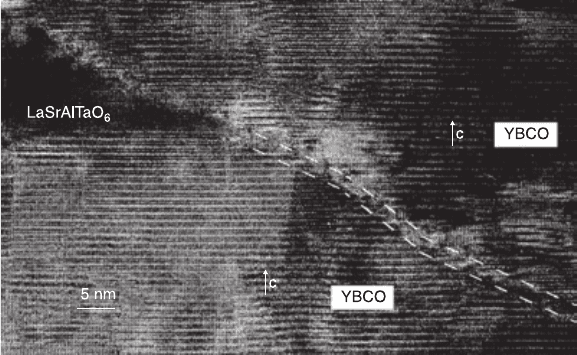
High-T
c
Josephson junctions 343
1
2
3
4
5
6
7
8
9
10
1
2
3
4
5
6
7
8
9
20
1
2
3
4
5
6
7
8
9
30
1
2
3
4
5
6
7
8
9
40
1
2
43X
© Woodhead Publishing Limited, 2011
These thin parts of the superconductor show modified properties and act as normal or
semiconducting barriers. An impressive TEM picture of such a ramp-edge junction
with a ‘native’ barrier of about 2 nm thickness from Wen et al. (2000) is shown in
Fig. 8.22. For an excellent review of TEM on ramp-edges with different materials
including ‘interface engineered’ barriers see Merkle et al. (1999). The nature of the
barrier material determines the transport mechanism. Tunnelling through insulators
requires very thin layers which can be hardly realized in planar SIS junctions with
insulating barriers. Up to now there exist only a few groups successfully working
with such planar SIS junctions and it is not clear if additional current contributions
like tunnelling via traps or hopping processes dominate the simple tunnelling
mechanism. Kito et al. (2002) therefore introduced an additional PrGaO
3
layer and
got excess-current free junctions with I
c
R
N
products of about 2 mV at 4.2 K. For
semiconducting (Sm) barrier materials the thickness can be enhanced, but the
problem with additional current contributions is enhanced too. Also the effect of
induced superconductivity (proximity effect) has to be taken into account.
For some materials even an anomalous or ‘gigant proximity effect’ was
reported, e.g. Golubov and Kuriyanov (1998), leading to barrier thicknesses of up
to 200 nm. This gave a good chance to use the simple trench geometry of Sm-S
bilayers (Fig. 8.9b) but problems with interface resistance as well as with
microshorts across the trench appeared (Barholz et al., 2000). The trench geometry
8.22 TEM picture of a ramp-edge junction with a ‘native’ barrier
(thickness about 2 nm) indicated by dashed lines, so-called interface-
engineered junction. The crystallographic c-axis direction of the YBCO
films is given by arrows (Wen et al., 2000, Fig. 2, Copyright (2000) by
Elsevier Science Ltd). Reprinted with permission from Wen JG, Satoh
T, Hidaka M, Tahara S, Koshizuka N, and Tanaka S (2000), ‘TEM study
on the microstructure of the modified interface junction’, Physica C 337,
249–255, Fig. 2, Copyright (2000) by Elsevier Science Ltd.
344 High-temperature superconductors
1
2
3
4
5
6
7
8
9
10
1
2
3
4
5
6
7
8
9
20
1
2
3
4
5
6
7
8
9
30
1
2
3
4
5
6
7
8
9
40
1
2
43X
© Woodhead Publishing Limited, 2011
with a N-S bilayer also was used for MgB
2
epitaxially grown on normal conducting
TiB
2
films on SiC substrate by Chen et al. (2006). A trench smaller than 50 nm
was realized by e-beam lithography and ion milling or by focussed ion beam. The
junctions show RSJ-like IV-characteristics up to 31 K.
The use of normal conducting barriers gives the chance to enhance the barrier
thickness again but leads to other transport mechanisms as proximity effect and
multiple Andreev reflections have to taken into account. Additional problems
appear because materials usable for epitaxy often show magnetic ordering effects
leading to strong influences on superconductivity and Josephson effects.
The directly written junctions or modified bridges use barrier material which is
produced by electron or ion beams, thus many aspects of technology can use these
materials and their properties. The changes in the material by electron beams
mostly are not stable at room temperature but this can be improved by a thermal
annealing step. An excellent review on these FEBI junctions was given by
Pauza et al. (1997) and the proximity effect coupling was described by Booij
et al. (1997). On the other side, the ion beam modified materials are stable but
were dominated by complex behaviour, e.g. bridges work as Josephson
junctions only in a very limited temperature range, see e.g. Schmidl et al. (1997),
Katz et al. (2000), and the short review of Tinchev (2007) including the references
therein.
8.4.2 Preparation and performance of artificial barrier
junctions
Most of the problems in preparation of artificial barrier junctions are based on
their physical problems given above. The heteroepitaxy problem is mainly solved
for selected material combinations. Two examples are shown in Fig. 8.23, for
details see the review of Merkle et al. (1999). Molecular beam epitaxy (MBE),
laser MBE and pulsed laser deposition (PLD) show excellent results for multilayer
systems with crystallographically fitting materials. The metal electrodes (mainly
Au) are included in devices as well as passivation and protection layers.
The simple technology for modified microbridge junctions seems to be of
interest for many junction circuits where the junction can be placed everywhere
on the substrate, but their quite low reproducibility, large parameter spread and
stability problems up to now have limited applications. The junction behaviour is
strongly dependent on the barrier properties and the transport and coupling
mechanisms. Instead of clear Josephson coupling these additional effects lead to
differences in the IV-characteristics (often flux-flow like but RSJ-like at lower
temperatures, Fig. 8.24), the microwave response, the temperature dependence of
the junction parameters or additional noise. Focused electron-beam irradiated
junctions with I
c
R
N
products of about 2 mV at 4.2 K, 650 µV at 40 K, and 120 µV
at 77 K have been demonstrated by Pauza et al. (1997). Ion beam modified
microbridges reach 200 µV at 45 K but have a spread in critical currents of up to
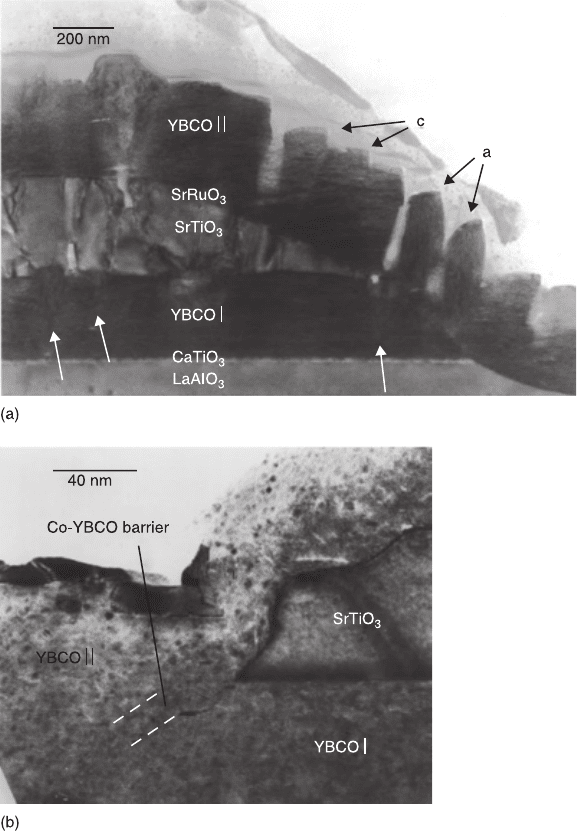
High-T
c
Josephson junctions 345
1
2
3
4
5
6
7
8
9
10
1
2
3
4
5
6
7
8
9
20
1
2
3
4
5
6
7
8
9
30
1
2
3
4
5
6
7
8
9
40
1
2
43X
© Woodhead Publishing Limited, 2011
8.23 TEM pictures of artifical barrier junctions: (a) YBCO/SrRuO
3
/
YBCO ramp-edge, (b) Co-YBCO barrier SNS ramp-edge. In (a) some
a- and c-oriented grains are marked by arrows (Merkle et al., 1999, Figs
9 and 16b, Copyright (1999) by Elsevier Science Ltd). Reprinted with
permission from Merkle KL, Huang Y, Rozeveld S, Char K, and Moeckly
BH (1999), ‘Electron microscopy of high-T
c
Josephson junctions formed
in the epitaxial layer ramp-edge geometry: YBCO/barrier/YBCO’,
Micron 30, 539–559, Figs 9 and 16b, Copyright (1999) by Elsevier
Science Ltd.
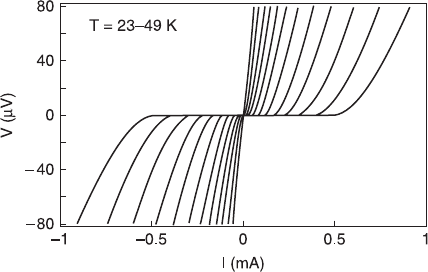
346 High-temperature superconductors
1
2
3
4
5
6
7
8
9
10
1
2
3
4
5
6
7
8
9
20
1
2
3
4
5
6
7
8
9
30
1
2
3
4
5
6
7
8
9
40
1
2
43X
© Woodhead Publishing Limited, 2011
40% (Katz et al., 2000). Further improvement of the I
c
R
N
product was obtained
by Sirena et al. (2007) by increasing the ion energy.
It should be mentioned that ion beam modified junctions have been realized too
for MgB
2
superconductors by Cybart et al. (2006). Twenty-junction arrays and
single junctions with an I
c
R
N
product of 75 µV at 37.2 K have been demonstrated.
In contrast to low-T
c
devices the artificial barrier layer type is not the
standard junction technology for HTS. The interface-engineered barriers will be
a way out towards applications, because I
c
R
N
products over 5 mV at 4.2 K with a
good uniformity in I
c
for more than 100 junctions were obtained by Shimakage
et al. (2001).
8.4.3 Selected applications of artificial barrier junctions
The recent progress in single flux quantum (SFQ) device technology in Japan is
based mainly on the development of interface-engineered ramp-edge junctions
(Tanabe and Hidaka, 2007). The spread in the critical current for one hundred
junctions is smaller than 10% (Satoh et al., 2001) while the I
C
R
N
product is larger
than 1 mV at 40 K (Morimoto et al., 2006). SFQ circuits with up to 200 Josephson
junctions were realized. A variety of elementary SFQ circuits such as a toggle
flip-flop, switches and an analog-to-digital converter have been designed for
operation temperatures of 30 to 50 K, while a prototype on-chip sampler system
is being developed by Maruyama et al. (2007) for demonstration of bandwidth
over 100 GHz for optical input signals, Fig. 8.25.
8.24 IV-characteristics of ion beam modified microbridges (film
thickness 50 nm, slit width 250 nm) showing in general a flux-flow
behaviour depending on preparation and working temperature. Only
at lower temperatures is there an RSJ-like behaviour (Schmidl et al.,
1997, Fig. 7, Copyright (1997) by Springer Science and Business Media).
Reprinted with permission from Schmidl F, Dörrer L, Wunderlich S,
Machalett F, Hübner U, et al. (1997), ‘Superconducting properties of ion
beam modified YBCO microbridges’, J. Low Temp. Phys. 106, 405–416,
Fig. 7, Copyright (1997) by Springer Science and Business Media.
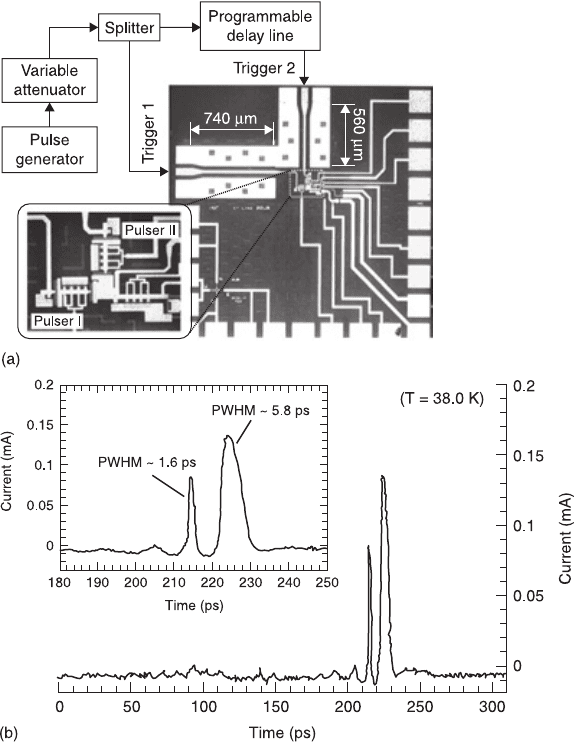
High-T
c
Josephson junctions 347
1
2
3
4
5
6
7
8
9
10
1
2
3
4
5
6
7
8
9
20
1
2
3
4
5
6
7
8
9
30
1
2
3
4
5
6
7
8
9
40
1
2
43X
© Woodhead Publishing Limited, 2011
As one example for application of ion beam modified junctions, the
superconducting quantum interference filters (SQIFs) of Cybart et al. (2008)
should be mentioned, even if they could be included in the SQUID chapter, too.
The SQIFs are SQUID-like arrays with a special variation of loop size leading to
8.25 SFQ sampler system using interface-engineered ramp-edge
junctions: (a) block diagram and microphotograph of the on-chip
sampler for pulse measurement. The inset shows an enlargement of the
circuit. (b) Measured current pulse (Maruyama et al., 2007, Figs 2 and
5, Copyright (2007) by Elsevier Science Ltd). Reprinted with permission
from Maruyama M, Wakana H, Hato T, Suzuki H, Tanabe K, et al. (2007),
‘Observation of SFQ pulse using HTS sampler’, Physica C 463–465,
1101–1105, Figs 2 and 5, Copyright (2007) by Elsevier Science Ltd.
348 High-temperature superconductors
1
2
3
4
5
6
7
8
9
10
1
2
3
4
5
6
7
8
9
20
1
2
3
4
5
6
7
8
9
30
1
2
3
4
5
6
7
8
9
40
1
2
43X
© Woodhead Publishing Limited, 2011
one single peak in their voltage-flux dependence with very large transfer
coefficients
∂
V/
∂
B (see e.g. Schultze et al., 2003 and references therein). Series
arrays of 280 such incommensurate SQUIDs from YBCO ion damage Josephson
junctions show a spread of critical currents of 12% only and result in a maximum
transfer function of 105 V/T.
8.5 Intrinsic Josephson junctions
8.5.1 Physics of intrinsic Josephson junctions
Since the discovery of the intrinsic Josephson effects by Kleiner et al. (1992) a lot
of works have been published concerning the physics of the intrinsic junctions,
e.g. Kleiner and Müller (1994), Kim et al. (1999), Yurgens (2000), Wang et al.
(2001a, 2001b, 2005, 2009), Tachiki et al. (2005, 2009), Gray et al. (2009). Thus
we will restrict ourself here to facts which are relevant for application.
The crystal structure of the high-T
c
superconducting cuprates offers a natural
way to realize Josephson junctions on an atomic scale. The superconducting CuO
2
-
planes are separated by coupling layers of some tenth of a nanometer. This leads to
many differences compared to artificially prepared planar barrier junctions with
quite compact superconducting electrodes and much thicker single barrier layers.
For example the magnetic field dependence of the critical Josephson current is still
a Fraunhofer-like dependence, eq. [8.2], but relating to the atomic size of the
junction (total junction thickness is about 1.5 nm) a flux quantum requires new
fields in the Tesla range. This is an advantage for some applications where stable
Josephson currents even in higher fields are necessary. The other main difference
to artificial junctions is that intrinsic junctions are naturally series arrays instead of
single junctions. Thus the observed IV-characteristic is a sum of single junction
characteristics leading to many branches up to high voltages, Fig. 8.26. For very
high voltages the heat dissipation leads to non-equilibrium effects and negative
differential resistance parts in the IV. While the number of junctions in the intrinsic
arrays is quite easy to control by thickness of the stack of superconducting unit
cells their homogeneity is still a problem. Thus there is a quite large spread in
single junction parameters. If the spread can be reduced, the internal synchronization
of the junctions improves the dynamic of these arrays. Additional shunting or
resonance environment can further improve the synchronization leading to a
collective many-junction behaviour (Grib and Seidel, 2009; Grib et al., 2002;
Seidel et al., 2001; Wang et al., 2000). This is of relevance, for example, for
radiation sources realized by intrinsic arrays. The lateral dimensions of intrinsic
Josephson junctions play a crucial role, too. Perpendicular to the atomic arrays
there is flux-flow of Josephson vortices corresponding to these dimensions. This
results in plasma waves and additional dynamic effects; for details see the reviews
of Saval’ev et al. (2010) and Hu and Lin (2010). On the one hand, such effects can
be applied for radiation sources (Gray et al., 2009; Tachiki et al., 2005), while on
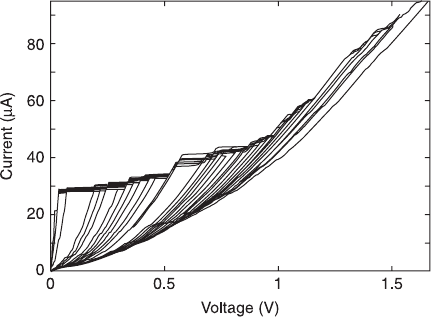
High-T
c
Josephson junctions 349
1
2
3
4
5
6
7
8
9
10
1
2
3
4
5
6
7
8
9
20
1
2
3
4
5
6
7
8
9
30
1
2
3
4
5
6
7
8
9
40
1
2
43X
© Woodhead Publishing Limited, 2011
the other hand they lead to a complex behaviour and additional noise contributions,
see e.g. Wang et al. (2009), Tachiki et al. (2009) and references therein.
8.5.2 Preparation and performance of intrinsic Josephson
junctions
While the first investigations on the intrinsic junctions used single crystals like
whiskers or etched parts out of them, different thin film technologies have since been
developed. Thin film structures used a mesa-type geometry whereas the high-T
c
film
is patterned with lateral dimensions in the µm range, e.g. Schmidl et al. (1995),
Haruta et al. (2009) and references therein. The problem of metal electrodes to the
mesas was solved by Seidel et al. (1996) even for a four-point-measurement which
requires two separated contacts on top of each mesa, see Fig. 8.27. A very interesting
technology of preparation of quite homogeneous and well-defined junction arrays
was proposed by Kim et al. (1999) for single crystal whiskers and later adapted by
Wang et al. (2001b) to single crystal pieces mounted on substrates. Focussed ion
beams were used to etch the small well-defined stack of junctions out of the material
from two sides in a way that the remaining high-T
c
materials act as electrodes to the
stack. By this ‘double-sided fabrication method “or” flip-chip technique’ the quality
and homogeneity of the intrinsic junction arrays was dramatically improved.
Other technologies were developed to realize a very small junction number
down to the single junction limit, see e.g. Yurgens (2000), You et al. (2006), and
Yurgens et al. (2008). Koval and co-workers (2010) showed that T
C
, I
C
and R
N
of
8.26 Typical IV-characteristics of an intrinsic Josepshon junction array
showing multiple branches (Schmidl et al., 1995, Fig. 5, Copyright
(1995) by IOP Publishing Ltd). Reprinted with permission from
Schmidl F, Pfuch A, Schneidewind H, Heinz E, Dörrer L, et al. (1995),
‘Preparation and first measurements of TBCCO thin film intrinsic
stacked Josephson junctions’, Supercond. Sci. Technol. 8, 740–743,
Fig. 5, Copyright (1995) by IOP Publishing Ltd.
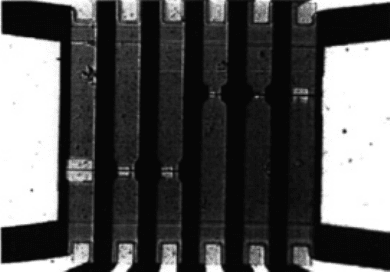
350 High-temperature superconductors
1
2
3
4
5
6
7
8
9
10
1
2
3
4
5
6
7
8
9
20
1
2
3
4
5
6
7
8
9
30
1
2
3
4
5
6
7
8
9
40
1
2
43X
© Woodhead Publishing Limited, 2011
intrinsic Bi-2212 Josephson junctions can be tuned in a large range by current
injection. This carrier injection effect is reversible and persistent.
An alternative way to realize a thin film intrinsic stacked junction array uses
substrates with a surface not parallel to the CuO
2
-planes (Chana et al., 2000). On
such vicinal cut substrates the film grows with CuO
2
-planes tilted with respect to
the surface (Fig. 8.14c). Patterning of a microbridge results in a nearly horizontal
stack of junctions and the length of the microbridge corresponds to the number of
junctions in series. Intrinsic Josephson behaviour of the microbridges was observed
for misorientation angles equal or larger than 15 degrees (Mans et al., 2006). This
kind of array offers new possibilities for synchronization (Grib et al., 2006).
8.5.3 Selected applications of intrinsic Josephson junctions
Wang et al. (2001a, 2001b) have demonstrated the impressive performance of
their devices, like the response to microwaves up to the THz range. Additionally,
complex 2-D arrays, 3-D arrays and artificial shunted junctions with improved
synchronization have been realized leading to components and performance
required for applications, see Wang et al. (2002, 2003). Based on the high-quality
complex devices, a voltage standard using intrinsic junctions was proposed and
tested by Wang et al. (2001b, 2002, 2003). Zero-crossing Shapiro steps with
irradiation at 1.6 THz have been observed, Fig. 8.28. The ‘double sided fabrication
method’ was extended to 3-D stack arrays with up to 2500 intrinsic junction
stacks on a chip, Fig. 8.29. For a 256-stack array with about 11 000 junctions,
zero-crossing steps up to a voltage of 2.4 V have been observed. The advantage
8.27 Thin film intrinsic Josephson junctions using a mesa-like geometry
(six mesas from 3 × 3 to 10 × 10 µm
2
) and electron beam cut Au electrodes
for four-point measurements (Seidel et al., 1996, Fig. 2c, Copyright (1996)
by IOP Publishing Ltd). Reprinted with permission from Seidel P, Schmidl
F, Pfuch A, Schneidewind H, and Heinz E (1996), ‘Investigations on high-T
c
thin film intrinsic stacked Josephson junctions’, Supercond. Sci. Technol.
9, A9–A13, Fig. 2c, Copyright (1996) by IOP Publishing Ltd.
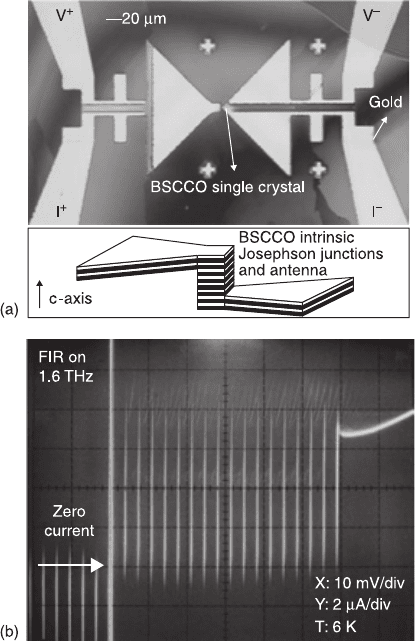
High-T
c
Josephson junctions 351
1
2
3
4
5
6
7
8
9
10
1
2
3
4
5
6
7
8
9
20
1
2
3
4
5
6
7
8
9
30
1
2
3
4
5
6
7
8
9
40
1
2
43X
© Woodhead Publishing Limited, 2011
would be the high working temperature which can be realized by liquid nitrogen
or a cryocooler leading to very compact voltage standards.
The use of intrinsic arrays as radiation sources up to some THz, i.e. especially
for the FIR range where such compact small sources can replace big CO
2
-laser
pumped systems, is restricted by the low power of emission of non-synchronized
arrays. Even if this power was enhanced by several µW within the last few years,
these sources are far from real applications.
8.28 Terahertz response of intrinsic Josephson junctions: (a) optical
image of a stack prepared out of a BSCCO single crystal with an
integrated bow-tie antenna (schematically shown at the bottom) and r.f.
filters all glued onto a silicon substrate; (b) zero-crossing Shapiro steps
under microwave irradiation of 1.6 THz (Wang et al., 2001a, Figs 1 and
3b, Copyright (2001) by the American Physical Society). Reprinted with
permission from Wang HB, Wu PH, and Yamashita T (2001a), ‘Terahertz
response of intrinsic Josephson junctions in high-T
c
superconductors’,
Phys. Rev. Lett. 87, 107 002, Figs. 1 and 3b, Copyright (2001) by the
American Physical Society.
